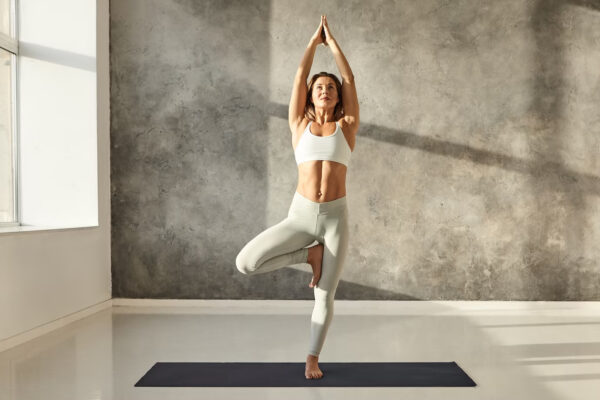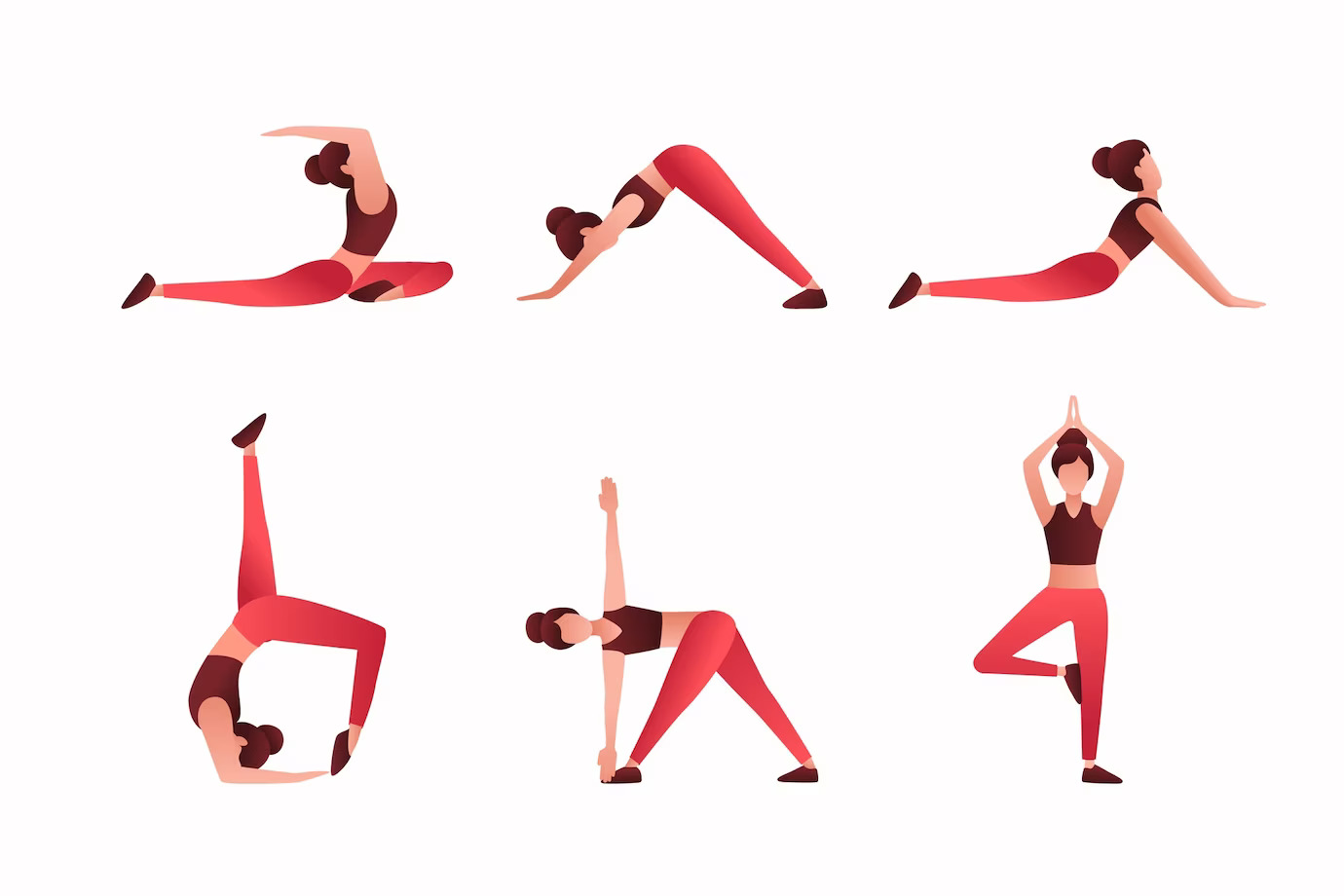Mountain Pose (Tadasana)

Mountain Pose, also known as Tadasana, is a foundational standing posture in yoga. Here are the steps to practice Mountain Pose:
Begin by standing tall with your feet together, arms at your sides, and your weight evenly distributed between both feet.
Engage your leg muscles, pressing down through the soles of your feet, and lift the arches of your feet.
Draw your tailbone down toward the floor, lengthening your spine and lifting the crown of your head toward the ceiling.
Roll your shoulders back and down, and open your chest.
Relax your arms at your sides with your palms facing forward.
Soften your facial muscles, jaw, and throat.
Take slow, deep breaths, feeling grounded and rooted like a mountain.
Hold the pose for several breaths, feeling the strength and stability of your body.
Mountain Pose is a great pose for beginners, as it is simple yet foundational. It helps improve posture, balance, and focus. It can also help relieve tension in the neck and shoulders, and promote overall relaxation and grounding. Mountain Pose is often used as a starting point for many other standing yoga postures.
Downward-Facing Dog Pose (Adho Mukha Svanasana)

Downward-Facing Dog Pose, also known as Adho Mukha Svanasana, is a popular yoga posture that is often practiced as part of a sun salutation sequence. Here are the steps to practice Downward-Facing Dog Pose:
Begin on your hands and knees in a tabletop position, with your wrists directly under your shoulders and your knees under your hips.
Spread your fingers wide and press down through your palms, engaging your arm muscles.
Tuck your toes under and lift your hips up and back, straightening your arms and legs.
Aim to create an inverted V shape with your body, with your tailbone lifting up toward the ceiling and your heels reaching toward the floor.
Keep your head and neck relaxed, and gaze between your legs or toward your navel.
Engage your leg muscles, pressing your thighs back and lifting your kneecaps.
Draw your shoulder blades down your back and widen your collarbones.
Breathe deeply and hold the pose for several breaths.
To release the pose, exhale and lower your knees to the floor.
Downward-Facing Dog Pose is a great posture for stretching and strengthening the entire body. It helps improve flexibility in the hamstrings, calves, and spine, while also building strength in the arms, shoulders, and core. Downward-Facing Dog can also help relieve stress and tension, and promote overall relaxation and focus. It is a great posture to practice in the morning to wake up the body and mind, or in the evening to unwind and release tension from the day.
Child's Pose (Balasana)

Child’s Pose, also known as Balasana, is a gentle and restful yoga posture that is often used as a resting pose during yoga practice. Here are the steps to practice Child’s Pose:
Begin on your hands and knees in a tabletop position, with your wrists directly under your shoulders and your knees under your hips.
Spread your knees wide apart, keeping your big toes touching.
Lower your hips back toward your heels, resting your buttocks on your heels.
Exhale and fold your torso forward, bringing your forehead to the floor.
Stretch your arms out in front of you, or rest them alongside your body with your palms facing up.
Take slow, deep breaths, feeling the stretch in your hips, thighs, and spine.
Hold the pose for several breaths or as long as comfortable.
To release the pose, inhale and gently roll up to a seated position.
Child’s Pose is a great posture for calming the mind and releasing tension from the body. It can help relieve stress and anxiety, as well as gently stretch the hips, thighs, and spine. Child’s Pose is also a great posture for resting and restoring energy during yoga practice. It is a safe and comfortable pose for most people, including beginners and those with injuries or limitations.
Warrior II Pose (Virabhadrasana II)

Warrior II Pose, also known as Virabhadrasana II, is a standing yoga posture that strengthens and stretches the legs, hips, and torso. Here are the steps to practice Warrior II Pose:
Begin in a standing position at the top of your mat with your feet hip-distance apart.
Step your left foot back about 3-4 feet, turning it out to a 90-degree angle, so that your left heel is aligned with your right heel.
Bend your right knee, keeping it directly over your ankle, and turn your left foot out slightly to stabilize your stance.
Raise your arms to shoulder height, parallel to the floor, with your palms facing down.
Gaze over your right hand and hold the pose for several breaths.
Engage your leg muscles, especially the inner thighs, and press down through the outer edge of your back foot.
Keep your shoulders relaxed and your chest open.
Breathe deeply, sinking deeper into the pose with each exhale.
To release the pose, straighten your right leg and lower your arms, returning to a standing position.
Repeat the pose on the other side, stepping your right foot back and turning your left foot out.
Warrior II Pose is a powerful posture that builds strength and stability in the legs, hips, and core, while also stretching the chest and shoulders. It can help improve balance and concentration, as well as promote a sense of grounding and stability. Warrior II Pose is a great posture to practice during a flow sequence or as a standalone pose. It is safe and accessible for most people, but those with knee or hip injuries should use caution and modify the pose as needed.
Tree Pose (Vrikshasana)

Tree Pose, also known as Vrikshasana, is a standing yoga posture that strengthens the legs, improves balance, and promotes concentration. Here are the steps to practice Tree Pose:
Begin in a standing position at the top of your mat with your feet hip-distance apart.
Shift your weight onto your left foot and bend your right knee, bringing your right foot to rest on your inner left thigh.
Press your foot and thigh together, finding balance and stability in the pose.
Bring your hands to your heart center in prayer position.
Fix your gaze on a steady point in front of you to help maintain your balance.
Take several deep breaths, feeling the stretch in your standing leg and the strength in your core.
You can hold the pose for several breaths, or for as long as comfortable.
Release the pose by lowering your right foot back to the ground, and repeat the pose on the other side.
Tree Pose is a great posture for building strength and stability in the legs and core, while also promoting balance and concentration. It can help improve posture and alignment, as well as relieve stress and anxiety. Tree Pose is a safe and accessible pose for most people, including beginners and those with injuries or limitations, but it is important to avoid placing your foot directly on your knee joint, and instead rest your foot on your inner thigh or lower leg.












